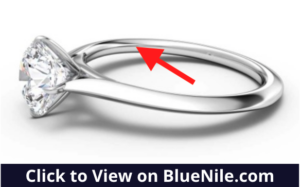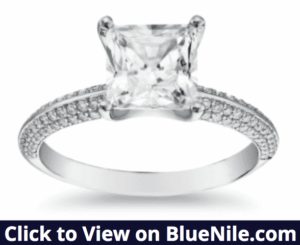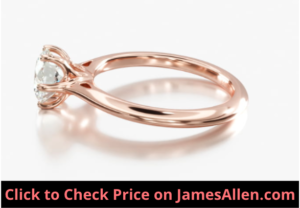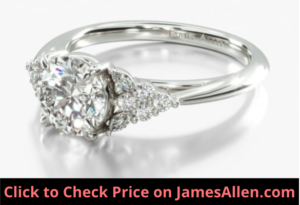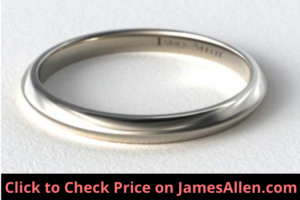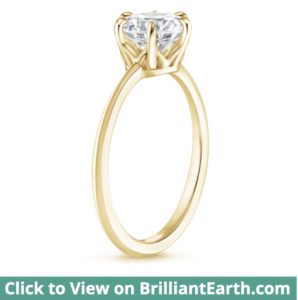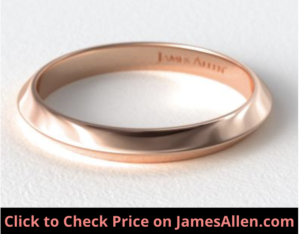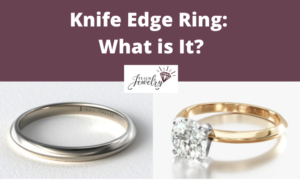
If you’re shopping for a ring, it’s easy to focus on finding the right diamond. But don’t neglect to explore all the options available for the setting.
The band can complete the look of your diamond ring and accentuate its shine or serve as the perfect standalone fit in the form of a wedding band or fashion piece.
One style of ring that fits this category is a knife edge, known for its sleek, slim appearance.
We’ll explore everything you need to know about knife edge rings, including:
- An overview
- Pros and cons
- Alternatives
- How to choose the right one for you
Let’s dive into all the details.
What are Knife Edge Rings?
A knife edge ring features a band that slopes up from each edge, meeting at a high line in the middle. In this way, it splits into two parts.
Check out the knife edge ring below with a round-cut diamond at its center, where I’ve highlighted its distinguishing trait.
Notice how it appears to break in two down the middle. It continues this aesthetic around the whole piece.
There are also designs where the band only slopes upward as it approaches the center diamond. It’s called a partial knife edge because it only divides the ring in two at the front.
Knife edge rings aren’t the most common type of shank, but they’re one of my favorites.
In fact, I chose a 2mm knife edge ring for my wife’s engagement ring.
The sharp edge running around the outer part of the ring gives it a sense of elegance as it holds a solitaire, round-cut diamond.
The first knife edge ring was developed by Tiffany & Co. to form its famous Tiffany setting. Today, it’s used across a variety of jewelry from engagement and wedding rings to everyday pieces without gemstones.
Pros of Knife Edge Rings
Versatility
One of the most attractive qualities of knife edge rings is versatility. Because of the unorthodox angles the two sloped sides create, there’s room to play with different styles.
For example, here’s a design that features two rows of diamonds on each side of the knife edge.
There are 142 in total streaming halfway down both sides of the ring for a total carat weight of 3/8. There are even diamonds on the prongs holding the center diamond.
Solitaire knife edge settings also have unique designs even though they lack the brilliance of ones with more diamonds.
To illustrate, here’s one in 14K rose gold with six prongs.
The prongs weave through each other on the way up to the main diamond, but the ring still maintains its clean, knife edge style. It’s only when viewed from the profile that you notice its unique style.
The most simplistic knife edge ring is one for a wedding band.
It’s a full knife edge without any diamonds.
Makes Diamond Look Bigger
Another upside of knife edge rings is the illusion of size it gives to the main gem.
If you place the diamond above a knife edge, your eyes are drawn to the thin raised edge, as opposed to the entirety of a thick band that lays flat.
While nothing physically is different than if it were a wide, thick band, the sleek nature of the knife edge results in the diamond gaining more prominence in the piece.
The diamond I chose for my wife’s ring was less than one carat, so I wanted a thin setting that brought out its size as much as possible.
The diamond still appears large because the ring isn’t detracting from it with a wide shank or additional diamonds.
Pairs With Wedding Rings
Knife edge rings are a popular choice for engagements because they pair well with wedding rings. Many couples are interested in stacking the engagement and wedding rings together in a way where each piece complements the other.
While some might consider contrasting metals or styles, a more cohesive aesthetic is also appealing.
To illustrate, here’s a knife edge engagement ring in platinum that also features marquise diamonds on both sides of the round cut.
It’s a stunning engagement ring that commands attention because of its intricate details.
Now check out this 2mm knife edge wedding ring in platinum.
If you ignore the diamonds on top of the engagement ring, you’ll notice the two rings are complementary and easily stackable.
The center diamonds and accents won’t bump into the wedding ring.
Instead, they’ll sit next to each other for a stylish combination.
This is why I recommend having a sense of what style wedding ring you’ll choose while in the process of finding an engagement ring. Even though they’re often given months apart, it’s helpful to choose ones that pair well together.
Cons
Potentially Uncomfortable Fit
A common complaint from owners of knife edge rings is they find them uncomfortable. It’s important to note this isn’t a universal response to wearing these bands.
My wife wears hers everyday and sometimes during physical activity and said she’s never felt bothered by its feel.
One reason is because despite the ridge on the exterior of the ring, the inside is smooth.
By viewing this angle of the ring, you see how there aren’t any ridges on the inside.
It lays flat and matches the curve of your finger in every position.
Nonetheless, it’s useful to have the opportunity to try one on, whether it be a friend’s or at the jewelry store.
The uneven design of some, like partial shanks, can cause the ring to fit differently on each side. This is occasionally cited as an annoyance.
More Easily Damaged
The unique profile comes with structural drawbacks. Because it features a sharp edge, impacts can leave noticeable dents, cutting into the center line.
This line, symmetrical or not, is thinner at the top.
Another factor to consider is the type of metal, whether silver, gold, or platinum.
Because they’re prone to damage, opting for softer metals may accentuate any dents it receives. It’s possible to do repairs, but the likelihood alone is a downside.
Knife edge rings are more likely to experience issues if there are small diamonds lining the band. If they aren’t placed properly or they experience impact, they can fall out of the setting.
Unfortunately, that requires professional repairs.
But the cleaning process for knife edge rings is similar to other styles. Apply warm water and dish soap, and pat it dry.
If it has pave or milgrain, take care you don’t dislodge any of these features while cleaning it.
How to Choose a Knife Edge Ring
Style
If you’re considering a knife edge ring, make sure the style of setting you choose is the right fit.
Assuming it does, look into your options for diamond accents, bezel settings, and other design elements. Often, there are more options available than you might think when working with a knife edge ring.
For example, this version includes pavé on both sides of the knife edge.
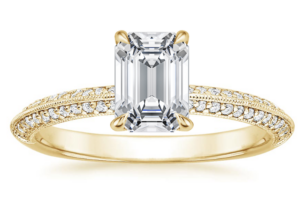
But it isn’t for everyone. If your job requires working with your hands or significant physical activity, it’s best to be aware of the danger that poses to your ring.
You may want another option you can wear in those situations and save the quality knife edge ring for other occasions.
Pick your variation of the knife edge, from partial to asymmetrical, and you have yourself a sleek, modern take on the age-old ring.
Price
The price of a knife edge ring depends on a few factors, including the type of metal, width, and embellishments.
We’ll start with metal.
The price of this knife edge wedding ring differs depending on whether it’s made of gold or platinum.
Here’s its price range:
- 14K gold (white, yellow, or rose): $430
- 18k gold (white, yellow): $630
- Platinum: $560
You’ll also pay more for a 2.5mm band than one that’s 2mm.
For example, this 2mm knife edge ring costs $330.
This 2.5mm version is the same ring but wider. There’s a price premium that brings it to $430.
Knife edge rings with embellishments raise the price because of the pave or milgrain that lines it.
Here’s an example with both.
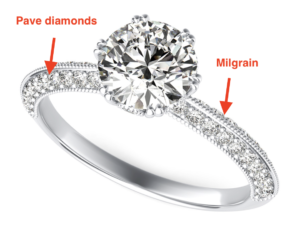
When you subtract the price of the diamond, the cost of the ring lands close to $1,000.
If you want to put as much of your budget as possible toward the center diamond, choose a simple knife edge design.
Alternatives
If you don’t think knife edge rings are right for you, there are alternatives to consider. In fact, the design is just one of many commonly found on engagement and wedding rings.
One of the most popular alternatives to knife edge rings is a comfort fit.
Here’s an example in 14K rose gold.
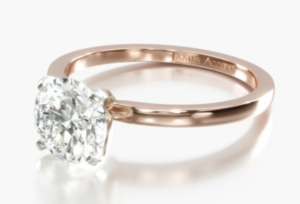
Take a minute to view the piece on the jeweler’s website, and rotate it 360 degrees. Identify what distinguishes it from a knife edge.
The answer is it doesn’t come to a point in the middle in a way that cuts the piece in half. It’s smooth all the way around.
Another style that’s vastly different from a knife edge is a wide band. When you view the example below, you’ll know where it gets its name.
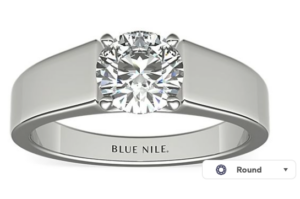
The ring is 5mm wide, compared to many knife edge rings which are between 2mm and 3mm.
As my last example, there are tapered designs. This style starts wide at the bottom and then narrows as it approaches the ring.
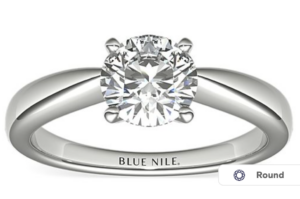
It’s worth exploring alternatives and learning which ring is the best fit for you.
How to Decide if a Knife Edge Ring is Right for You
If you’re deciding whether a knife edge ring is right for you, understand each aspect of the style and what to expect when you wear one.
There are variations that range from simple to ones filled with elements that bring even more sparkle to the piece.
Here are some tips to help you know it’s the right choice for you.
Consider a knife edge ring if:
- You want a versatile ring that’s available in a variety of metals and widths
- You’ve chosen a smaller center diamond and want to maximize its appearance relative to the ring
- You’re interested in stacking an engagement and wedding ring
Explore knife edge rings and how they fit your chosen diamond, and you’ll create the perfect piece for you.

Jacob Clarke
Jacob Clarke is the founder of TeachJewelry.com.
He earned an Applied Jewelry Professional Diploma from the Gemological Institute of America (GIA) and now brings you essential information about diamonds, settings, and more.
Jacob has consulted with leading jewelry brands, and his work has been cited in Clean Origin, Diamond Nexus and industry publications.
He's also a member of the International Gem Society.
He enjoys discussing jewelry with readers, so contact him with any questions at jacob.clarke@teachjewelry.com.

